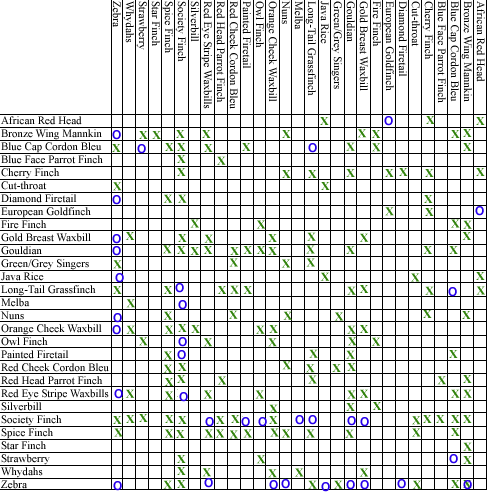Finch Species Compatibility Chart
..can't they all just get along?
by Myra
Articles and Information - Lady Gouldian Finch
One question I am asked a lot is which species can be housed together. There are many possibilities and a lot of it depends on how much money and space you wish to invest in your finches. One pair of finches in a nice sized cage is perfectly fine for most people. Others want mixed flights and/or a full aviary.
There are many variables that come into play when picking species to live together. The chart below brings 3 things into the equation.
- 1) Temperament (during breeding season)
- 2) Size
- 3) Diet
Because of the limited viewing space for most web browsers I've kept the chart down to only the most commonly found species and a few exotics. Omitted are the highly aggressive species, which shouldn't be housed with other finches unless you have a huge finch enclosure (the size of a small house would do.) These species include Weavers, Bullfinches, Pekin Robins, Saffron's, Tanagers and Combassou's,
While this chart is a good guideline it's by no means the last word in anything. These are individual finches and each finch has a personality. Some will naturally be more aggressive than others will and some will naturally be more docile than others. These variations are normal within any species.
The general rules to selecting a mix of finch species are:
- 1) All finches should be about the same size
- 2) Don't house finches of the same color together. (If you put a group of red cheeked finches together you are just asking for trouble)
- 3) All finches should be of about the same temperament.
- 4) Only 1 pair of each species per flight. (this doesn't apply to Society, Zebra, and many of the Waxbills which are very social finches)
- 5) Two square feet (or 61 cm) of personal space per pair of finches.
- 6) More space is required for any finch larger than a Zebra or Society.
- 7) Finches should have about the same diet requirements.
Chart Notes:
- The green X's indicate there is rarely trouble housing this species together
- The blue O's indicate that while these species can be housed together, they may interfere with one another's breeding.
- The blank areas show which species shouldn't be housed together.
- This chart is based on the assumption that you plan to house 1 breeding pair per species. In places where you see the same species marked as compatible it means you may house more than one pair of that species together. Example: Zebra finches. You may house a pair of zebra finches with a pair of zebra finches.

© lady gouldian finch.com 2017